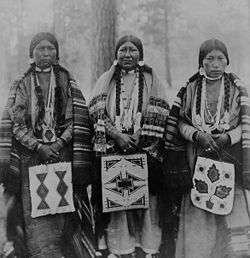Confederated Tribes of Warm Springs
The Confederated Tribes of Warm Springs is a recognized tribe made of three tribes who put together a confederation of Native American tribes who currently live on and govern the Warm Springs Indian Reservation in the U.S. state of Oregon.

Tribes
The confederation consists of three tribes of the Pacific Northwest:
- The Sahaptin-speaking Tenino people, divided into four subtribes: Upper and Lower Deschutes (the Tygh and the Wyam), the Dalles Tenino, and the Dock-Spus (John Day);
- Two bands (The Dalles a.k.a. the Ki-gal-twal-la, and Dog River) of Wasco Indians who spoke a dialect of Upper Chinook
- The Northern Paiutes, who speak an offshoot of the Uto-Aztecan language family related to Shoshonean, had a way of life very different from the Warm Springs and Wasco bands.
Overall History
Before becoming the Confederated Tribes of Warm Springs the three tribes; Wasco, Warm Springs, and Paiute, lived along the Columbia River and Cascade Mountains. They all spoke different languages and had their own custom ways. The Warm Springs and Wasco tribes traded and conversed frequently while the Paiute's language prevented them from frequent contact because it was foreign to the other tribes. In 1800, immigrants from the east first started to arrive, by 1852 around 12,000 settlers crossed the tribes' territories each year. The Warm springs and Wasco signed a treaty with Joel Palmer in 1855 after dealing with their traditional ways of life being disrupted by the settlers for many years. By signing the treaty the Wasco and Warm Springs tribes relinquished 10 million acres of land to the United States and kept 640,000 acres for their own use. The first people from the Paiute tribe to arrive on reservation were the 38 Paiutes that were forced to move onto the Warm Springs Reservation from the Yakama Reservation in 1879. Soon more arrived and they eventually became a permanent part of the Warm Springs Reservation.[1] The Confederated Tribes adopted a constitution in 1938, after the construction of Bonneville Dam flooded the major fishing site at Cascades Rapids. Upon receiving a $4 million settlement in compensation for the 1957 flooding of Celilo Falls by the construction of The Dalles Dam, the Tribes used part of the sum to build the Kah-Nee-Ta resort, which opened in 1964.[2]
In 2001, members of the Confederated Tribes persuaded the Oregon Legislative Assembly to pass a bill mandating that the word squaw be changed in numerous place names.[3]
Wasco
History
Culture
Language
The Wasco language, known as Kiksht, has been passed down through generations of Warm Spring Tribe members. There is a concerted effort underway to try to preserve the ancestral language of the Wasco people, through educational programs and language repositories. The United States Governmental policy of assimilation (1790 – 1920) nearly erased this language.[4] The young tribe members that attended governmental educational facilities were only permitted to speak English, and were forbidden to speak in their native tongue. The 2012 loss of the last tribal elder, Gladys Thompson, who was fully fluent in the language has caused the language to become nearly extinct. Language preservation efforts include the Central Oregon Community College 100 level course in Kiksht Native Language. The instructor for this course, Ms. Valerie Switzler, is the recipient of the Linguistic Society of America's Excellence in Community Linguistics Award 2016. The Endangered Languages Archive at SOAS University of London has preserved recordings of Conversational Kiksht.[5]
Warm Springs
Bands
These bands are split into different places but are the part of the same tribe. The bands of the Warm Springs tribe consists of Tenino, the Lower Deschutes, also called Wyam, the John- Day or Dock-Spus, and finally the Upper Deschutes or Tygh.[6]
History
Culture
Language
The Warm Springs band spoke a language called Sahaptin. Today there are only about 50 people who speak it fluently and none of them are under fifty years old.
Paiute
History
The Northern Paiutes had dominated South Eastern Oregon, Southern Idaho, Northern and Southern Nevada, and Northern California, with parts of Montana, and Utah
Culture
Language
The language the Northern Paiutes use is Numu
See also
| Wikimedia Commons has media related to Warm Springs Indian Reservation. |
- List of Native American Tribal Entities in Oregon
- Kah-Nee-Ta High Desert Resort and Casino, a resort on the Warm Springs Reservation
- Columbia Gorge casino, the Confederated Tribes' proposed casino in the Columbia River Gorge
References
- "History". Confederated Tribes of Warm Springs.
- "The Oregon Story". Oregon Public Broadcasting. 2001. Retrieved 2008-03-19.
- Sanders, Eli (December 11, 2004). "Renaming 'Squaw' Sites Proves Touchy in Oregon". The New York Times.
- Frederick Hoxie, (1984). A Final Promise: The Campaign to Assimilate the Indians, 1880–1920. Lincoln: University of Nebraska Press.
- Endangered Languages Archive at SOAS University of London, Conversational Kiksht https://elar.soas.ac.uk/Collection/MPI194590
- "The Confederated Tribes of the Warm Springs Reservation of Oregon". www.critfc.org/. Columbia River Inter-Tribal Fish Commission. Retrieved 6 December 2016.
External links
- The Confederated Tribes of Warm Springs (official website)